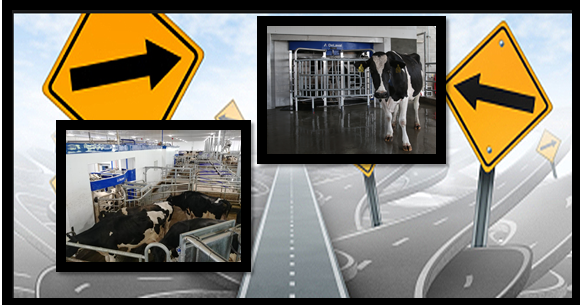Home
Learn
Trending Topics
Cow Traffic Systems for Retrofit Robot Barns
Cow Traffic Systems for Retrofit Robot Barns
Yes, there are staunch defenders of both guided and free flow – and DeLaval supports the installation of both – but it’s not as simple as choosing a “side.” Depending on the situation – and more often in retrofits – there are modifications to the systems. We call this cow traffic type modified guided.

There are many possible modifications, but we will focus on one in this article. My goal is to help you understand how free flow and guided systems work and then to understand how one modified system may work better than the others.
Understanding cow movement
Before choosing a cow traffic system, it is critical to understand why a cow eats, why a cow gets up from her stall, and why she moves or flows around the barn. This movement usually leads to her eating at the bunk, the VMS™ or even a feed station.
The desire to eat and take in feed is heavily influenced by the feed leaving the rumen. Feed leaves two ways: 1) through digestion – nutrients going into the blood to help keep the animal alive, move, stay warm, grow, and make milk, and 2) through passage, otherwise known as manure. When the digestion and rate of passage increases, then the cow will eat more. She will get up more often to eat and she may have bigger meal sizes. When the digestibility of the feed is greater she can eat more, make more milk and be milked more often.
It doesn’t matter if it is free flow, guided or modified guided, the forages will influence her flow. The gates in a guided system should never influence her flow unless there is a conscious effort from the farmer to do so. DeLaval recommends that cows always be able to visit the bunk unless, of course, she is diverted to be milked. Gates should never stop a cow from walking through them.
What influences a cow in a free flow system to get up and flow or move to the VMS or the feed bunk:

- Cows are lying in their stalls, “on their own” they will get up
- They make a choice of going to the bunk or the VMS
- Cow traffic to the VMS is driven by higher levels of pellets and lower energy at the bunk
- Higher levels of pellets are often consumed (12 lbs or 5 kg/cow/day)
- Forage digestibility increases these, levels can be reduced
- Visiting the bunk six to 10 times per day is driven by:
- Forage digestibility
- Cow health (no fever, no metabolic issues and no lameness)
- Barn design
- Cow behavior (delivery of fresh feed, time of day, buddy system, training)
What influences a cow in a guided flow system to get up and flow or move to the VMS or feed bunk:

- Cows are lying in their stalls, “on their own” they will get up
- They walk to the bunk via a preselection gate
- Cow traffic to the gate is driven by a desire to eat at the bunk; higher energy nutrition at the bunk to meet needs more like a total mixed ration (TMR)
- Visiting the bunk six to 10 times per day is driven by:
-
- Forage digestibility
- Cow health (no fever, no metabolic issue, no lameness)
- Barn design
What influences a cow in a modified guided system:
The same as the above two patterns, except you have one row of cows facing the feed bunk and two rows. The partial mixed ration (PMR) is mixed normally with a lower energy or starch than guided but can be higher than with free flow. The nutritionists have to watch what the cows are doing and will adjust accordingly.
| System New Build | Retrofit | Kg or lbs pellets/cow/day |
| Free Flow | Both | 5 kg or 12 lbs/cow/day |
| Guided | More often new builds | 3.25 kg or 7 lbs/cow/day |
| Modified Guided | Both | 4.25 kg or 9 lbs/cow/day |
Why Free Flow:
- Simple
- Lower initial investment
- Feeding more pellets is economically acceptable
- Feed Advisor has experience
Why Guided:
- Your focus on highly digestible forages fits so you can reduce pellet consumption in the VMS
- Labor efficiency is a priority
- Feed Advisor has experience with this system
Why Modified Guided:
- You have a three- or six-row barn for a retrofit
- You like three- or six-row barns
- This will give you some labor efficiency
- This may allow you to reduce pellet intake in the VMS depending on the forage digestibility
All systems can work, the question is: what is the right system for you? When you pick the right system, then you will have success. Your DeLaval dealer can talk about your options and help you decide which system is best for you.
